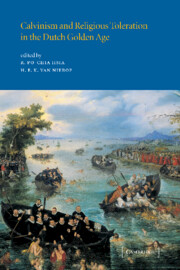Book contents
- Frontmatter
- Contents
- Notes on contributors
- 1 Introduction
- 2 ‘Dutch’ religious tolerance: celebration and revision
- 3 Religious toleration in the United Provinces: from ‘case’ to ‘model’
- 4 The bond of Christian piety: the individual practice of tolerance and intolerance in the Dutch Republic
- 5 Religious policies in the seventeenth-century Dutch Republic
- 6 Paying off the sheriff: strategies of Catholic toleration in Golden Age Holland
- 7 Sewing the bailiff in a blanket: Catholics and the law in Holland
- 8 Anabaptism and tolerance: possibilities and limitations
- 9 Jews and religious toleration in the Dutch Republic
- 10 Religious toleration and radical philosophy in the later Dutch Golden Age (1668–1710)
- 11 The politics of intolerance: citizenship and religion in the Dutch Republic (seventeenth to eighteenth centuries)
- Select bibliography
- Index
5 - Religious policies in the seventeenth-century Dutch Republic
Published online by Cambridge University Press: 08 July 2009
- Frontmatter
- Contents
- Notes on contributors
- 1 Introduction
- 2 ‘Dutch’ religious tolerance: celebration and revision
- 3 Religious toleration in the United Provinces: from ‘case’ to ‘model’
- 4 The bond of Christian piety: the individual practice of tolerance and intolerance in the Dutch Republic
- 5 Religious policies in the seventeenth-century Dutch Republic
- 6 Paying off the sheriff: strategies of Catholic toleration in Golden Age Holland
- 7 Sewing the bailiff in a blanket: Catholics and the law in Holland
- 8 Anabaptism and tolerance: possibilities and limitations
- 9 Jews and religious toleration in the Dutch Republic
- 10 Religious toleration and radical philosophy in the later Dutch Golden Age (1668–1710)
- 11 The politics of intolerance: citizenship and religion in the Dutch Republic (seventeenth to eighteenth centuries)
- Select bibliography
- Index
Summary
There is a general and long-standing agreement among historians that the Dutch Republic was tolerant on the issue of religion. Still, it is not at all easy to determine how this celebrated toleration actually worked out in practice. It is evident that religious toleration was a hotly debated issue. Jonathan Israel has recently mapped out these discussions and the shifts in their focus. This makes religious toleration an obvious object of study in the history of ideas. The leap from these ideas and discussions to the practicalities that ruled interconfessional relations in the Dutch Republic is seldom attempted, partly because our knowledge of toleration in practice, and why it worked the way it did, is still highly impressionistic.
Toleration as a topic in Dutch historiography
This gap in our understanding of the place of religion in Dutch society, and how this society coped with religious diversity, is mainly a product of historiographical trends in the past. Religious toleration has long been, and still is, an item of national pride, and historians have not been really interested in the particulars of its legal basis and the policies that gave it its characteristic form. Historiographically religious toleration is embedded in the nineteenth-century contest over Dutch national identity that resulted in the famous verzuiling or ‘pillarization’. Two strands of argument have to be mentioned here. The first puts toleration in the context of an ongoing struggle between intolerant ministers and humanist magistrates, between Calvinists and Libertines.
- Type
- Chapter
- Information
- Publisher: Cambridge University PressPrint publication year: 2002
- 6
- Cited by



